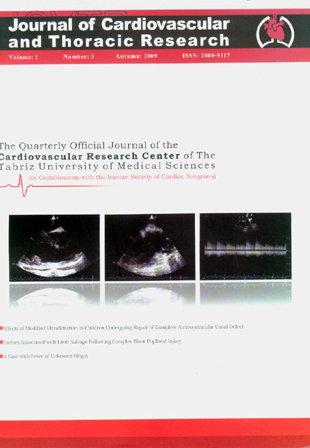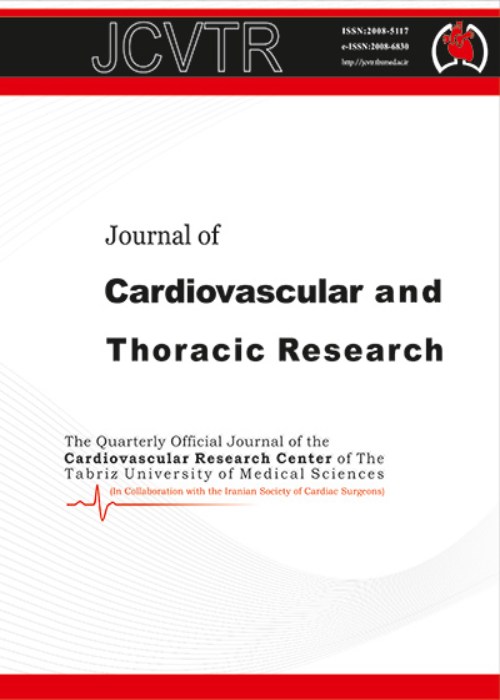فهرست مطالب

Journal of Cardiovascular and Thoracic Research
Volume:1 Issue: 3, Aug 2009
- 64 صفحه،
- تاریخ انتشار: 1388/11/01
- تعداد عناوین: 11
-
-
Page 1Background
Cardiopulmonary bypass (CPB) results in whole body inflammatory response syndrome and increased total body water. Consequently there is an increased risk of bleeding and organ dysfunction following procedures where CPB has been used. Modified ultrafiltration (MUF) is shown to reverse some of the deleterious effects of CPB.
MethodsThis is a retrospective study of children undergoing repair of complete atrioventricular canal defect (CAVCD). Two groups of children were studied; in the MUF group modified ultrafiltration was used to remove body water post-CPB, in the Non-MUF group no ultrafiltration was used.
ResultsThere were twenty patients in each group. The two groups were similar regarding age, sex, weight, preoperative blood parameters, and intraoperative and postoperative management. Children in the MUF group had significantly less postoperative blood loss, and required less red cell and plasma transfusions. The MUF group had significantly lower dopamine requirements; however there was no difference with regard to adrenaline requirements. Lastly the MUF group had significantly shorter ventilation period and ICU stay.
ConclusionsModified ultrafiltration in children undergoing repair of CAVCD results in lower blood loss and blood products requirements. In addition these children are extubated earlier and have shorter intensive care stay.
Keywords: Ultrafiltration, Heart Defects Congenital, Cardiopulmonary Bypass -
Page 5BackgroundNonpenetrating tracheobronchial disruption are rare and potentially life threatening and associated with blunt thoracic trauma. Sometimes diagnosis is missed.Methods2340 traumatic patients were admitted to the trauma center of Tabriz University Hospital, Iran. Only twelve patients of them had ruptured tracheobronchial airways following blunt chest trauma. In this retrospective study of twelve patients, we aim to document and evaluate causes, presentation, and diagnosis and treatment modalities over fourteen years (1993- 2006).ResultsAll the cases admitted to our referral hospital from six hours to 72 hours, underwent surgical interventions. There were two deaths; one in the operating room because of massive bleeding of pulmonary vascular disruptions coexisted with trachobronchial injuries and in other due to severity of disruption of carina, right and left bronchus five days after repair. Diagnosis was missed in one patient and he repaired after six month. Stricture formation of anastomotic site and localized empyema with bronchopleural fistula were the complications of two patients.ConclusionA high-level of suspicion in blunt thoracic trauma and use of bronchoscopy confirm the diagnosis of tracheobronchial disruption. Early diagnosis of tracheobronchial disruption is important, but severity of disruptions predisposes mortality.Keywords: Chest Trauma, Tracheobronchial Rupture, Blunt Trauma
-
Page 9BackgroundThe purpose of this study is to report management techniques and factors associated with early limb salvage following high risk popliteal vascular injury. Additionally controversial aspects of popliteal vascular injury management unique to an Iranian trauma center are discussed.MethodsA retrospective analysis was conducted of prospectively collected data from Tabriz Medical Trauma Center. Patients were divided into two study groups: Group 1 Limb salvage and Group 2 Amputation. Subgroup analysis consisted of univariate analysis comparing the Group 1and Group 2 as well as multivariate analysis examining factors associated negatively and positively with the primary endpoint, limb salvage.ResultsSixty of the patients (97%) were male, two female (3%); the mean age was 34.years (16-49 years).. The overall amputation rate in the present study was 23 amputations (37 %).On logistic regression analysis, significant (P<0.05) independent factors associated negatively with limb salvage were combined tibia and fibula fracture (OR 0.133; CI 0.017 -1.018), concomitant artery and vein injury (OR 0.039; CI 0.004- 0.407), ligation of venous injury (OR 0.326; CI 0.161- 0.660), lack of back flow after Fugarty catheter thrombectomy (OR 0.129; CI 0.023-0.729), while repair of popliteal artery and vein injury (OR 2.81; CI 2.22 -6.53) when present was associated with improved early limb salvage.ConclusionExpeditious recognition of vascular injury, transport to repair and repair of associated venous injury when possible are necessary to optimize limb salvage. A low threshold for timely amputation when limb salvage is not possible is important to prevent life-threatening complications.Keywords: Popliteal injury, Amputation, Vascular Injury
-
Page 17BackgroundIt is estimated that cardiopulmonary disorders eslkjpecially coronary artery disease are the leading causes of mortality in world and Iran. The arteriosclerotic process in the coronary arteries, as in other blood vessels, consists of focal intimal accumulation of lipids, complex carbohydrates, blood and blood products, fibrous tissue, and calcium deposits associated with changes in the media, that causes unstable angina and myocardial infarction. Treatment of these patients is medical therapy and coronary artery bypass grafts surgery (CABGs) with or without cardiopulmonary by pass (CPB). The aim of this research is studying One Years Clinical Out come after Coronary Artery Bypass.MethodsThis research is cross sectional and case control trial study. It was performed in Shahid Madani hospital in Tabriz – iran during the year 2006-2007. The patients who had CABGs with or without CPB were studied. The information was collected by filling a questionnaire and was analyzed by the t-test and chi-square program.ResultsIn this study 196 patients had CABG without CPB (group I) and 133 with CPB (group II). Number of grafts in group I 2.49 ± 0.04 and 2.73 ± 0.04 in group II. The rate of complications in 2 groups was not significant, EF is improved in group I, and use of Inotrops and IABP was less than in group II. In group I hospitalization (ICU, hospital) was less than in comparison with group II.ConclusionAccording to results CABG without CPB is a safe method. According to results out comes of this study is comparable with other studies in world.Keywords: Coronary Artery Bypass Grafts (CABGs), Cardiopulmonary Bypass (CPB)
-
Page 23BackgroundPulmonary thromboendarterctomy is a curative surgery. However, it is associated with high mortality and morbidity. It’s accomplished under a period of circulatory arrest, thereby increasing the risk of surgical complications, especially neurologic sequelae. In present study, the surgical result of this procedure without the use of circulatory arrest has been presented.MethodsEleven patients with the mean age of 34±11 year underwent pulmonary thromboendarterctomy, using CPB, moderate hypothermia, and low pressure perfusion by single surgeon from April 2005 to June 2008 in the Rajaee Heart Center, Tehran. Half the patients had the evidence of involvement of segmental branches of pulmonary artery in CT angiography. Most patients presented in the NYHA class III. The mean pre-op PA pressure was 91.3±26mmHg. All patients were followed between 3-36 months.ResultsThere were three mortality cases in this study and the first two, were among the early experiences of the surgeon. The most common cause of mortality was respiratory failure and right-sided heart failure secondary to residual pulmonary hypertension. NYHA class improved in all survived. The mean post-op PA pressure was 39±13mmHg. Patients were intubated on the average of 75±4 hours. No neurologic complications were seen. One patient required extracorporeal life support system (ECLS) to wean from CPB off. Two patients had significant post-op bleeding due to coagulopathy and in the third one surgical source resulted in re-exploration.ConclusionIn this series, mortality was more than one expected. However with increased experience and the use of meticulous surgical techniques and improvement in peri-operative cares, mortality reduced significantly. Sufficient thromboendarterectomy is feasible without the use of circulatory arrest, while decreasing probable complication of TCA, especially neurologic ones. Failure to ameliorate pulmonary hypertension, during surgery, results, in high mortality and morbidity.Keywords: Pulmonary Hypertension, Pulmonary Emboli, Pulmonary Thromboendarterectomy, Respiratory Failure
-
Page 29BackgroundIn contrast to conventional on-pump coronary artery bypass grafting (CABG) surgery only mild increase of parameters of oxidative stress is reported during and after off-pump coronary artery bypass grafting. In this study, we attempted to determine the role of off-pump CABG in the myocardial and systemic inflammatory responses.MethodsOne hundred patients who underwent elective CABG were divided to three groups: 1) patients underwent off-pump CABG or 2) on-pump CABG surgery with controlled reperfusion and 3) on-pump CABG with noncontrolled reperfusion. We took patients systemic venous blood samples for the measurement of serum level malondialdehyde (MDA), TroponinC (cTnI) and total antioxidant (TAC) and blood level superoxiddismotas (SOD), before and after Ischemia and reperfusion.ResultsMean values of decrease left ventricular ejection fraction (LVEF) after surgery in patients group 3 were higher than patients group2 and also (LVEF) in patients group2were higher than patients group1(P<0.0001).There was significant difference in mean increase in CTnI levels among the three study groups (P <0.0001). The Serum concentration of MDA in the patients group3were significantly higher than other two groups (P <0.0001). The decrease SOD, TAC levels in patients patients group3were more than patients patients group2and than patients group1.ConclusionWe conclude that oxidative stress biomarker were increase in on-pump CABG. Controlled reperfusion on-pump CABG in comparison with noncontroled reperfusion on-pump CABG reduces oxidative stress. We conclude that off-pump CABG technique appears to reduce oxidative stress.Keywords: Off, pump, CABG, Reperfusion, Oxidative stress, Malondialdehyde
-
Page 35BackgroundIn this study effect of acute normovlumic hemodilution (ANH) to reduce consumption rate of allogenic blood transfusion was compared with the traditional protocol during and after cardiac surgery.MethodsOne thousand patients who underwent elective cardiac surgery (CABG, valve surgery) were entered into study. In ANH group (n=500) blood obtained from patients by using a new formula and re-transfused the collected blood at the end of operation. Total amount of allogenic packed red blood cell (PRBC) and fresh frozen plasma (FFP) transfusion in ANH group was compared with 500 patients that had been operated one year ago in our hospital (Historical Control).ResultsConsidering the patients baseline hematocrit values ANH technique was used in 59% of patients in ANH group, and 12% in control group. In ANH group fewer patients during operation transfused with PRBC and FFP than control group (23.2% vs 71.4%; p = 0.001 and 31.2% vs 77.4%; p = 0.008, respectively). Significantly lower mean PRBCs units transfused in ANH group comparing with control group (1.1± 0.5 vs 2.4 ± 1.3 units; p = 0.006). After surgery PRBCs and FFP transfusion were lower in ANH group than control group. Mean postoperative bleeding was not significantly different in the two groups (884 ± 304 ml vs 790± 291 ml; p = 0.312). The incidence of postoperative complications, ICU stay and in-hospital mortality between the two groups were not significantly different (p > 0.05).ConclusionIn this study, using the ANH significantly reduce consumption of allogeneic red blood cell and FFP in cardiac surgery patients.Keywords: Cardiac Surgery, Acute Normovolemic Hemodilution, Transfusion, Postoperative Complications
-
Page 43Many studies have reported on the association between human coronary artery disease (CAD) and certain persistent bacterial and viral infections. The aim of the present analysis was to investigate the possible association between HAV infection and angiography proven CAD. Blood from 200 patients undergoing coronary angiography was tested for antibodies to HAV by enzyme immunosorbent assay at Madani Heart Hospital, Tabriz University of Medical Sciences, Iran. CAD prevalence was 90% in HAV seropositive and 84.4% in HAV seronegative patients (Pv= 0.2). This analysis demonstrated that HAV seropositivity is not a risk factor for CAD.Keywords: Coronary Artery Diseases_Hepatitis A Virus_Inflammation_Infection
-
Page 51Full term neonate patient, about 3 kg weighs, admitted in child hospital because of Respiratory distress syndrome (RDS). Investigation by echocardiography reveled large aorto-pulmonary window (AP window) with sever coarctation of aorta. Findings at the time of operation were large AP window and interrupted aortic arch with patent ductus arteriosus (Berry syndrome). The anomalies corrected at the same operation. Unfortunately sever acidosis; brain and pulmonary edema, not responding to medical therapy contribute to patient''s death.Keywords: Pulmonary Window, Berry Syndrome, Interrupted Aortic Arch
-
Page 55Primary cardiac tumors are rare and occur in 1 per 1000 to 1 per 100000 individual in unselected autopsy series at tertiary heart centers. Approximately 75% of cardiac tumors are histologically benign and malignanat cardiac tumors are reminder of them. We describe a rare form of complicated benign cardiac mass in 46 years old man.Keywords: Fever, Unknown, Origin


